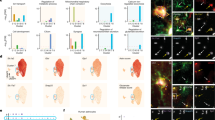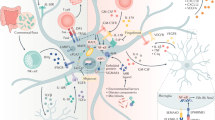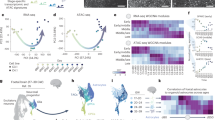Abstract
Tourette syndrome is a heritable neurodevelopmental disorder whose pathophysiology remains unknown. Recent genome-wide association studies suggest that it is a polygenic disorder influenced by many genes of small effect. We tested whether these genes cluster in cellular function by applying gene-set analysis using expert curated sets of brain-expressed genes in the current largest available Tourette syndrome genome-wide association data set, involving 1285 cases and 4964 controls. The gene sets included specific synaptic, astrocytic, oligodendrocyte and microglial functions. We report association of Tourette syndrome with a set of genes involved in astrocyte function, specifically in astrocyte carbohydrate metabolism. This association is driven primarily by a subset of 33 genes involved in glycolysis and glutamate metabolism through which astrocytes support synaptic function. Our results indicate for the first time that the process of astrocyte-neuron metabolic coupling may be an important contributor to Tourette syndrome pathogenesis.
Similar content being viewed by others
Log in or create a free account to read this content
Gain free access to this article, as well as selected content from this journal and more on nature.com
or
References
O’Rourke JA, Scharf JM, Yu D, Pauls DL : The genetics of Tourette syndrome: a review. J Psychosom Res 2009; 67: 533–545.
Deng H, Gao K, Jankovic J : The genetics of Tourette syndrome. Nat Rev Neurol 2012; 8: 203–213.
Scharf JM, Yu D, Mathews CA, Neale BM et al: Genome-wide association study of Tourette’s syndrome. Mol Psychiatry 2013; 18: 721–728.
Davis LK, Yu D, Keenan CL et al: Partitioning the heritability of Tourette syndrome and obsessive compulsive disorder reveals differences in genetic architecture. PLoS Genet 2013; 9: 1–14.
Wang L, Jia P, Wolfinger RD, Chen X, Zhao Z : Gene set analysis of genome-wide association studies: methodological issues and perspectives. Genomics 2011; 98: 1–8.
APA Diagnostic and statistical manual of mental disorders, 4th edn. Washington, DC, USA: American Psychiatric Association, 2000, Text revision (DSM-IV-TR).
Ruano D, Abecasis GR, Glaser B et al: Functional gene group analysis reveals a role of synaptic heterotrimeric G proteins in cognitive ability. Am J Hum Genet 2010; 86: 113–125.
Li K, Hornshaw MP, van Minnen J, Smalla KH, Gundelfinger ED, Smit AB : Organelle proteomics of rat synaptic proteins: correlation-profiling by isotope-coded affinity tagging in conjunction with liquid chromatography-tandem mass spectrometry to reveal post-synaptic density specific proteins. J Proteome Res 2005; 4: 725–733.
Li K, Hornshaw MP, Van der Schors RC et al: Proteomics analysis of rat brain postsynaptic density: Implications of the diverse protein functional groups for the integration of synaptic physiology. J Biol Chem 2004; 279: 987–1002.
Fernández E, Collins MO, Uren RT et al: Targeted tandem affinity purification of PSD-95 recovers core postsynaptic complexes and schizophrenia susceptibility proteins. Mol Syst Biol 2009; 5: 269.
Emes RD, Pocklington AJ, Anderson CN et al: Evolutionary expansion and anatomical specialization of synapse proteome complexity. Nat Neurosci 2008; 11: 799–806.
Goudriaan A, de Leeuw C, Ripke S et al: Specific glial functions contribute to schizophrenia susceptibility. Schizophrenia Bull 2014; 40: 925–935.
Lips ES, Cornelisse LN, Toonen RF et al: Functional gene group analysis identifies synaptic gene groups as risk factor for schizophrenia. Mol Psychiatry 2012; 17: 996–1006.
Whitlock MC : Combining probability from independent tests: the weighted Z-method is superior to Fisher's approach. J Evol Biol 2005; 18: 1368–1373.
Albin RL, Mink WM : Recent advances in Tourette syndrome research. Trends Neurosci 2006; 29: 175–182.
Singer HS, Morris C, Grados M : Glutamatergic modulatory therapy for Tourette syndrome. Med Hypotheses 2010; 74: 862–867.
Adamczyk A, Gause CD, Sattler R et al: Genetic and functional studies of a missense variant in a glutamate transporter, SLC1A3, in Tourette syndrome. Psychiatr Genet 2011; 21: 90–97.
Bélanger M, Allaman I, Magistretti PJ : Brain energy metabolism: focus on astrocyte-neuron metabolic cooperation. Cell Metab 2011; 14: 724–738.
Schousboe A, Bak LK, Madsen KK, Waagepetersen HS : Amino acid neurotransmitter synthesis and removal; in Kettenman H, Ransom BR (eds). New York, NY, USA: Neuroglia, 2013, pp 443–456.
Barros LF : Metabolic signaling by lactate in the brain. Trends Neurosci 2013; 36: 396–404.
Acknowledgements
We are grateful to all the patients with Tourette syndrome who generously agreed to participate in this study. Furthermore, the members of the Tourette Syndrome Association International Consortium for Genetics are deeply indebted to the Tourette Syndrome Association for their guidance and support. This work was supported by a grant from the David Judah Fund, NIH grants NS40024 to DLP, JMS and the Tourette Syndrome Association International Consortium for Genetics, NIH grant NS16648 and a grant from the Tourette Syndrome Association to DLP, American Recovery and Reinvestment Act (ARRA) Grants NS40024-07S1 to DLP/JMS and NS16648-29S1 to DLP, NIH grant NS037484 to NBF and NIH grant MH085057 to JMS. The Broad Institute Center for Genotyping and Analysis was supported by grant U54 RR020278 from the National Center for Research Resources. Support was also provided by the New Jersey Center for Tourette Syndrome & Associated Disorders (through New Jersey Department of Health and Senior Services: 08-1827-FS-N-0) to GAH and JAT. Funding support for the Study of Addiction: Genetics and Environment (SAGE) was provided through the NIH Genes, Environment and Health Initiative (GEI) (U01 HG004422). SAGE is one of the GWAS funded as part of the Gene Environment Association Studies (GENEVA) under GEI. Assistance with phenotype harmonization and genotype cleaning, as well as with general study coordination, was provided by the GENEVA Coordinating Center (U01 HG004446). Assistance with data cleaning was provided by the National Center for Biotechnology Information. Support for the collection of data sets and samples was provided by the Collaborative Study on the Genetics of Alcoholism (COGA; U10 AA008401), the Collaborative Genetic Study of Nicotine Dependence (COGEND; P01 CA089392), and the Family Study of Cocaine Dependence (FSCD; R01 DA013423). Funding support for genotyping, which was performed at the Johns Hopkins University Center for Inherited Disease Research, was provided by the NIH GEI (U01HG004438), the National Institute on Alcohol Abuse and Alcoholism, the National Institute on Drug Abuse, and the NIH contract ‘High throughput genotyping for studying the genetic contributions to human disease’ (HHSN268200782096C). The data sets used for the analyses described in this manuscript were obtained from dbGaP at http://www.ncbi.nlm.nih.gov/projects/gap/cgi-bin/study.cgi?study_id=phs000092.v1.p1 through dbGaP accession number phs000092.v1.p. Statistical analyses were carried out on the Genetic Cluster Computer (http://www.geneticcluster.org), which is financially supported by the Netherlands Scientific Organization (NWO 480-05-003). We gratefully acknowledge financial support by NWO via the Complexity project (645.000.003) and TOP ZonMW (40-00812-98-07-032). ABS and DP received funding from the HEALTH-2009-2.1.2-1 EU-FP7 Synsys project (grant number 242167).
Author information
Authors and Affiliations
Consortia
Corresponding authors
Ethics declarations
Competing interests
Drs Scharf and Mathews have received research support from the NIH and the Tourette Syndrome Association (TSA) on behalf of the TSA International Consortium for Genetics (TSAICG). Drs Scharf and Mathews have received honoraria and travel support from the TSA and are members of the TSA Medical Advisory Board (CAM) and Scientific Advisory Board (JMS).
None of the funding agencies for this project (NINDS, NIMH, the Tourette Syndrome Association and the David Judah Fund) had any influence or played any role in (a) the design or conduct of the study; (b) management, analysis or interpretation of the data; (c) preparation, review or approval of the manuscript. The remaining authors declare no conflict of interest.
Additional information
Tourette Syndrome Association International Consortium For Genetics (TSAICG) members and additional Tourette Syndrome GWAS contributors Massachusetts General Hospital: JM Scharf (Site PI), DL Pauls, D Yu, C Illmann, L Osiecki, BM Neale; UCSF: CA Mathews (Site PI), VI Reus, TL Lowe; UCLA: NB Freimer (Site PI), S Service; University of Chicago: NJ Cox (Site PI), LK Davis; University of Montreal: GA Rouleau (Site PI), S Chouinard, Y Dion, S Girard; Utrecht University/VU Medical Center, Amsterdam: DC Cath (Site PI), D Posthuma, JH Smit, P Heutink; Yale University: RA King (Site PI), T Fernandez, JF Leckman; University of Toronto: P Sandor (Site PI), CL Barr; University of Utah: W McMahon (Site PI), G Lyon, M Leppert, J Morgan, R Weiss; Johns Hopkins School of Medicine: MA Grados (Site PI), H Singer; Baylor College of Medicine: J Jankovic; Rutgers University: JA Tischfield (Site PI), GA Heiman (Site PI)
Supplementary Information accompanies this paper on European Journal of Human Genetics website
Supplementary information
Rights and permissions
About this article
Cite this article
de Leeuw, C., Goudriaan, A., Smit, A. et al. Involvement of astrocyte metabolic coupling in Tourette syndrome pathogenesis. Eur J Hum Genet 23, 1519–1522 (2015). https://doi.org/10.1038/ejhg.2015.22
Received:
Revised:
Accepted:
Published:
Issue date:
DOI: https://doi.org/10.1038/ejhg.2015.22
This article is cited by
-
Astrocytes in human central nervous system diseases: a frontier for new therapies
Signal Transduction and Targeted Therapy (2023)
-
Dopamine-2 receptor antibody encephalitis presenting as pure tongue-biting in a tourette syndrome patient: a case report
BMC Psychiatry (2022)
-
Synaptic processes and immune-related pathways implicated in Tourette syndrome
Translational Psychiatry (2021)



